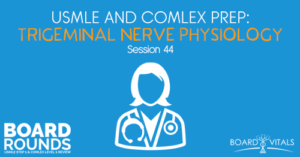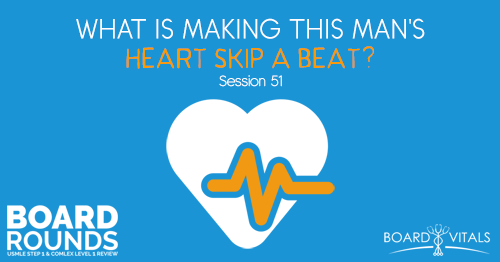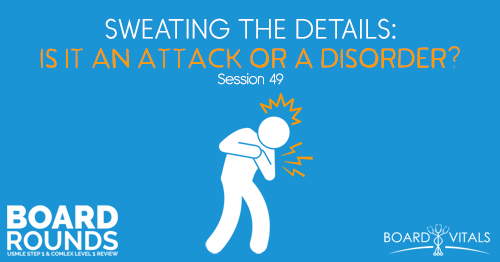Apple Podcasts | Google Podcasts

Session 44
Can you accurately identify the various functions of the trigeminal nerve and its major divisions? Follow along to test your knowledge of neuroanatomy!
We’re joined as always by Dr. Mike Natter from BoardVitals. Use the promo code BOARDROUNDS to save 15% off any of the packages that you buy there.
If you’re looking for QBanks, they have you covered with like 1700 and 1900 questions, tons of questions to get you the prep that you need. If you ask anyone, the best way to prepare for Step 1 or Level 1 is to maximize the number of questions that you do. Obviously not just doing the questions, but reading the explanations.
BoardVitals does an amazing job of giving you really fully in-depth answers and explanations as to why they’re the right answers and why the wrong answers are wrong. That is what makes a great product.
Listen to this podcast episode with the player above, or keep reading for the highlights and takeaway points.
[04:20] Question of the Week
Which of the following accurately describes the function of the trigeminal nerve and its major divisions?
(A) The brachial motor fibers in the maxillary branch supply the parotid gland
(B) Loss of the gag reflex when the soft palate is touched indicates a lesion affecting the pterygopalatine branch, which is down the nerve.
(C) The efferent fibers that mediate the corneal reflex travel in the nasal ciliary nerve derived from the ophthalmic division of the trigeminal nerve.
(D) Taste sensation for the anterior two-thirds of the tongue is carried in the lingual nerve, a branch of the mandibular division of the trigeminal nerve, V3.
(E) The masseter and temporal muscles are supplied with some manic afferents that travel in the two.
[05:21] Thought Process
There were these special fibers in the facial nerve that did the taste for the anterior two-thirds of the tongue. So I’m going to cross out D automatically. It’s the chorda tympani.
Motor fibers in the maxillary branch supply the parotid gland, the motor fibers, and the parotid gland. So I’ll put that one on the back burner.
Loss of the gag reflex when the soft palate is touch indicates a lesion affecting that pterygopalatine branch of the trigeminal nerve.
There are some sensory fibers that are coming off of the trigeminal that are mediating at the gag reflex. And so that’s why B here is actually correct, where the loss of gag reflex when the soft palate is touched. Meaning the afferent sensory side indicates that there’s a lesion affecting the pterygopalatine branch of the trigeminal nerve.
[10:26] Understanding the Incorrect Answer Choices
The branchial motor fibers of the trigeminal nerve join the mandibular branch where they provide innervation to the muscles of mastication. Mastication is chewing. Those are the tensor tympani, the tensor veli palatini, the mylohyoid and the anterior belly of the digastric.
The corneal reflex is the cornea. Actually, it’s an interesting piece of anatomy. It’s very highly innervated. It’s very sensitive. In fact, when we do death exams, one of the things we can do on brain dead exams is to see if there’s a corneal reflex.
If you just take a wisp of anything that kind of irritates the cornea, people have a very robust response to that. It’s like a very ingrained response because there are so many sensory fibers there. But there is no true blood supply there.
It kind of all happens through diffusion. So the cornea is a wonderful thing that can be transplanted which is fantastic. So basically for the corneum, it’s the nasal ciliary nerve, a branch of the ophthalmic, which is V1.
The motor responses are reflexes mediated by the facial nerve through the sematic efferents to innervate the orbicularis oculi. So that’s, that’s why C is actually incorrect and I’ll just continue that thought about the transplant.
Obviously, we transplant lots of things. But because of the lack of blood supply, there’s very, very, very little chance of rejection because your immune system isn’t going there because of the lack of blood supply.
Then E, the temporal muscles, the masseter, and the pterygoid are muscles of mastication that are innervated by the motor division of the mandibular branch of the trigeminal nerve.
[12:56] Final Thoughts
Again, think of rote memorization here. Really just understand the nervous system, about the facial nerve, the trigeminal nerve, where’s the one little branch that happens to shoot off somewhere that is going to be asked. Just have an understanding of those innervations and stuff as well.
Links:
BoardVitals (Use the promo code BOARDROUNDS to save 15% off.)
SEARCH SITE
LISTEN FOR FREE











